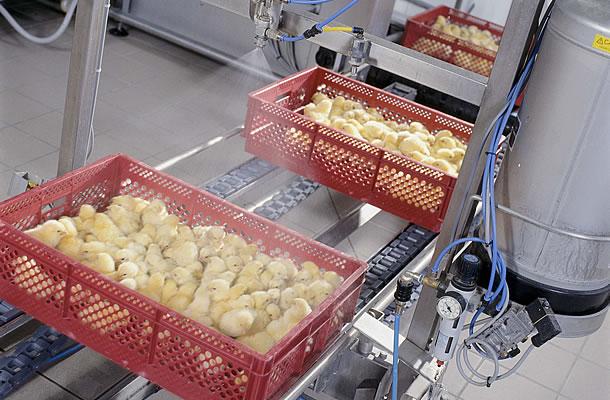Spray vaccination of day-old-chicks at the hatchery
Tags: Chick handling | Whitepaper
, September 11 2014

Spray vaccination is a method for administering respiratory vaccines, eg. for Newcastle Disease (ND) or Infectious Bronchitis (IB), when vaccinating birds for the first time.
Spray vaccination can be undertaken either in the hatchery or immediately after reception at the farm, while the chicks are still in boxes. Vaccinating in the hatchery is generally considered more effective, as the process is automated and therefore more controlled than the hand-spraying that tends to occur on the farm. Hatchery automated methods include either the use of a spray cabinet that is triggered each time a box of chicks is placed inside, or a spray vaccinator mounted over the conveyor line for chick boxes.
Vaccines suitable for spray delivery are live vaccines, produced by growing the required virus in incubated eggs or tissues cultures. After attenuation (=weakening), the viruses are freeze-dried and appear as a pellet in a glass vial containing 1,000 - 10,000 doses. This allows the vaccines to be stored under controlled conditions for several months until expiry date.
Prior to use, the vaccine is dissolved in water, after which it expires within hours and therefore must be used immediately. The water serves as a transport medium for the live virus to the day-old-chicks. Once sprayed, the vaccine will attach to the mucosa cells of the chicks’ eyes and upper respiratory tract. Preening (= cleaning feathers with beak) optimises uptake. Once in the body, the virus will multiply inside the mucosal cells, to develop good local immunity in the respiratory tract.
When administering vaccines by this method, it is important that the spray is ‘coarse’, ie. that droplets are at least 100 - 150 microns in size. Any smaller and the vaccine will be inhaled too deeply into the respiratory tract, resulting in an excessive post-vaccination reaction. This presents as mild disease symptoms in the flock 3- 5 days after vaccination - and will have a negative effect on production.
Advice
- Store vaccines in a refrigerator kept for this sole purpose until use.
- Follow the manufactures instructions for use carefully.
- Ensure that the water used for diluting the vaccine is of good quality, not chlorinated and low in mineral content. Use demineralised water if tap water does not meet these criteria.
- Dilute vaccines in a bucket or vessel only ever used for this purpose. Any traces of eg. disinfectant will kill the live, attenuated virus and render the vaccine ineffective.
- Adjust the spray vaccinator according to the size of the chick boxes and the speed of the conveyor belt. Check regularly that no vaccine is wasted and that the total surface of the chick box is uniformly covered by spray e.g. by placing absorbent paper inside an empty chick box.
- Apply coarse spray only. Install a suitable nozzle and adjust pressure to achieve this.
- Record the batch number of the vaccine used. In the case of an adverse reaction, this will help the manufacturer to track the problem.
- Inform customers which vaccination birds have received at the hatchery. Spray vaccination that targets the same organs within 10 - 14 days should be avoided.
- Do not mix different vaccines on your own initiative. If different vaccinations are required, use only registered combinations formulated by the vaccine manufacturer and tested for compatibility.
- Leave chicks in boxes for at least 20 minutes after spraying, to optimise the effect of preening.
- Avoid placing wet chicks in a chick despatch room with a suboptimal temperature or draught.